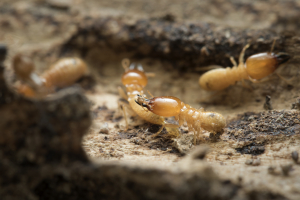Western Subterranean Termite Control
Termite control requires a comprehensive and integrated approach. Victoria Pest Control has extensive experience in treating and managing termite infestations throughout the Greater Victoria Area. Managing and eliminating termites in structures requires extensive knowledge of both the behaviour and biology of termites, and the structural elements involved. Victoria Pest Control is pleased to be a leader in environmentally conscious termite control, and has the knowledge and experience to create a successful treatment program to suit your needs. Call or email us at 250-477-0322 or info@victoriapestcontrol.com
With services for termite control Victoria has trusted for nearly 30 years, Victoria Pest Control is the right choice for handling your western subterranean termite problem.
Identification
The Western subterranean termite, or Reticulitermes hesperus, has three castes (types): workers, soldiers and reproductives. The worker termite is pale, about 6 mm long, wingless and has a round head. The soldier termite is wingless, about 6 mm long, and has a white body and long head. The reproductive termite is 13 mm long, has wings (which break off after swarming), and is dark brown to black in colour. The termite abdomen is broadly joined to the middle section, unlike the ant which has a very narrow joint.
Behaviour
Western subterranean termites colonize wood above or below the soil. The termite must remain in contact with moisture and will often build mud tubes to connect wet soil with wood above the soil. The termite will chew and digest wood (with the help of special digestive bacteria) and create tunnels, or galleries, in wood. Termite colonies, which can average 60,000 termites or more, have one or more queens and often a king. The queen may live for up to 30 years and workers up to 5 years. To spread their colony, termites swarm in the morning during warm weather and piles of discarded wings can be seen on the ground during this time. Termite damage in the home can be extensive, often unnoticed by home owners. The presence of mud tubes, swarms of termites inside the home, damaged wood with holes, and hollow sounding wood when tapped are indicators of possible termite infestation.
Prevention
Since the Western subterranean termite often attacks damp and decaying wood, it is important to reduce moisture in wood and to remove or replace damaged and rotting wood inside and outside the home. Ensure that there is a clearance of at least 15 cm between the soil and the wood siding around the exterior of the structure, and generally eliminate all contact between soil and wood. Use treated lumber where contact with the soil is unavoidable. Fill in cracks in the foundation and regularly inspect perimeter of home for signs of insect damage.

Pacific Dampwood Termite, bugguide.net
Pacific Dampwood Termite
Identification
The Pacific dampwood termite has three castes (types): workers, soldiers and reproductives. The worker termite is white with a brownish abdomen, about 20 mm long, wingless and has a round head. The soldier termite is wingless, about 20 mm long, has a reddish-brown body, and has a large head with long, black mandibles. The reproductive termite is 25 mm long, has wings (which break off after swarming), and is reddish-brown colour. The termite abdomen is broadly joined to the middle section, unlike the ant which has a very narrow join. The Pacific dampwood termite leaves large oval fecal pellets in the nest, whereas the Western subterranean termite does not.
Behaviour
Pacific dampwood termites colonize in moist and decaying wood in contact with the soil. The termite will chew and digest wood (with the help of special digestive bacteria) and create tunnels, or galleries, in the decaying wood. Termite colonies can have up to 4,000 termites. To spread their colony, termites swarm in late summer and piles of discarded wings can be seen on the ground during this time. Termite damage in the home can be extensive, often unnoticed by home owners. The presence swarms of termites inside the home, damaged wood with holes, and hollow sounding wood when tapped are indicators of possible termite infestation.
Prevention
Since the Pacific dampwood termite requires damp and decaying wood in which to live, it is important to reduce moisture in wood and to remove or replace damaged and rotting wood inside and outside the home. Ensure that there is a clearance of at least 15 cm between the soil and the wood siding around the exterior of the structure, and generally eliminate all contact between soil and wood. Use treated lumber where contact with the soil is unavoidable. Fill in cracks in the foundation and regularly inspect perimeter of home for signs of insect damage.
Control
Termite control requires a comprehensive and integrated approach. Consult a pest control professional to arrange for an estimate.


